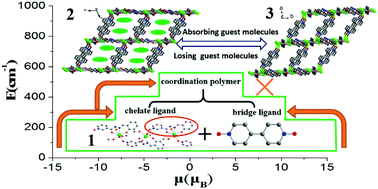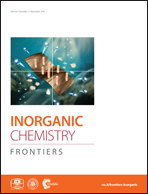Rational construction of a porous lanthanide coordination polymer featuring reversible guest-dependent magnetic relaxation behavior†
Abstract
A new three-dimensional porous lanthanide coordination polymer {[Dy(L)(μ2-bpdo)0.5(μ4-bpdo)0.5(CH3OH)]·ClO4·3CH3OH}n (2) featuring slow magnetic relaxation has been successfully assembled by reacting a superparamagnetic chain complex{[Dy(HL)(H2O)2(CH3OH)2]·2Cl·CH3OH}n (1) with an organic bridging ligand, namely, 4,4′-bipyridine-N,N′-dioxide (bpdo) (H2L = N′-(2-hydroxybenzylidene)-picolinohydrazide). Compared with 1, complex 2 has a higher magnetic anisotropy barrier, which arises from the variation of the ligand field around dysprosium ions and/or the existence of magnetic coupling between them induced by the bpdo ligand, leading to a thermal magnetic relaxation process through the second-excited doublet. Interestingly, complex 2 can undergo a reversible single-crystal-to-single-crystal conversion accompanying the desorption and adsorption of methanol molecules. The de-solvated phase, {[Dy(L)(μ2-bpdo)0.5(μ4-bpdo)0.5(CH3OH)]·ClO4}n (3), exhibits a slow magnetic relaxation process through the first-excited doublet, presenting the first example of reversible adjustment on the magnetic relaxation pathway regulated by guest molecules. This exciting finding offers a new perspective for enhancing the magnetic relaxation barrier.



 Please wait while we load your content...
Please wait while we load your content...